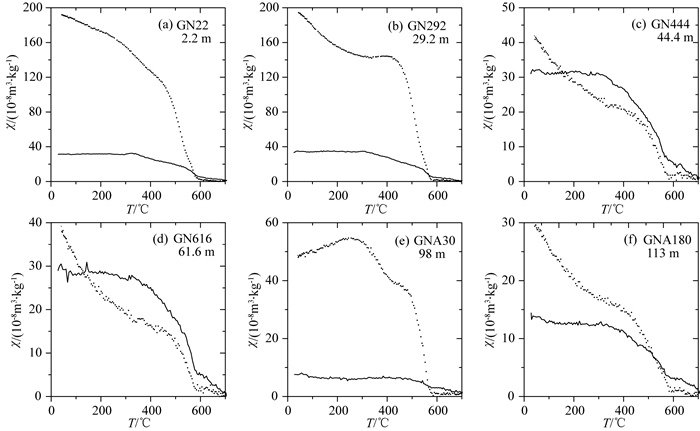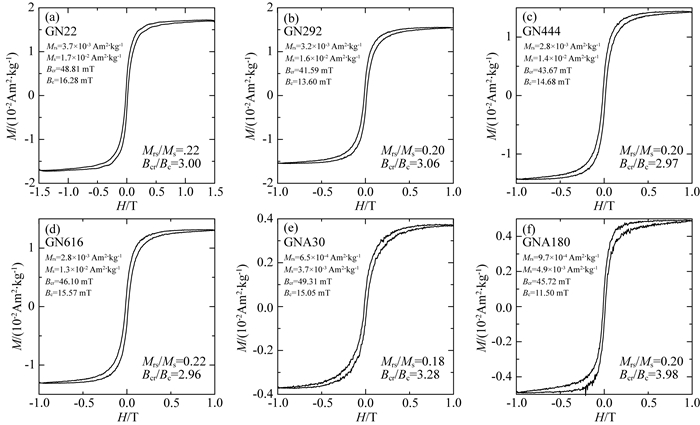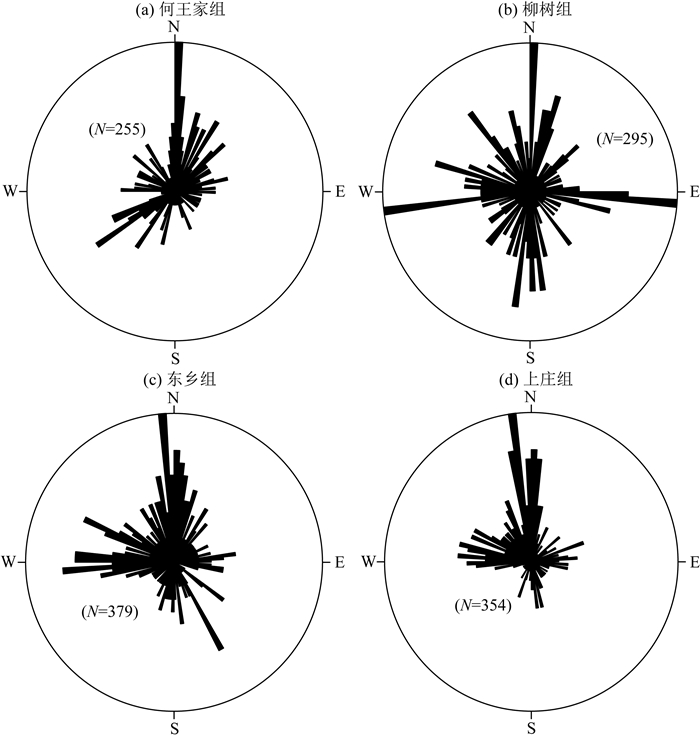2. 中国科学院地球科学研究院, 北京 100029;
3. 中国科学院大学地球与行星科学学院, 北京 100049;
4. 中国科学院古脊椎动物与古人类研究所, 中国科学院脊椎动物演化与人类起源重点实验室, 北京 100044
2. Institutions of Earth Science, Chinese Academy of Sciences, Beijing 100029, China;
3. College of Earth and Planetary Sciences, University of Chinese Academy of Sciences, Beijing 100049, China;
4. Key Laboratory of Vertebrate Evolution and Human Origins of Chinese Academy of Sciences, Institute of Vertebrate Paleontology and Paleoanthropology, Chinese Academy of Sciences, Beijing 100044, China
临夏盆地在东亚新生代地层、古气候、古生物研究方面占有举足轻重的地位.在自然地理上,临夏盆地处于东部季风区、西部干旱区及青藏高原高寒区三大自然带的交汇地带(方小敏等,2007),发育了古近纪末-新近纪河湖相地层及第四纪黄土,并含有丰富的哺乳动物化石(方小敏等,1997;邓涛等, 2004, 2018;Deng et al., 2013;Li et al., 2014;邓成龙等, 2018),为研究晚新生代一系列重大地质、环境事件,如青藏高原隆升、全球变冷、亚洲内陆干旱化以及亚洲季风演化提供了良好的研究材料(邓涛,2004;Fan et al., 2007;方小敏等,2007;Xu and Fang, 2008;Li et al., 2014;Yan et al., 2014).但是,关于临夏盆地沉积序列的高分辨率古环境研究还比较缺乏,制约了对其沉积环境变化的深入认识.本文以临夏盆地东部的郭泥沟剖面为研究对象,应用岩石磁学和磁组构方法,揭示临夏盆地中新世-早上新世的沉积环境演变过程.
1 研究区地质概况和样品采集临夏盆地位于青藏高原东北缘,是由雷积山深大断裂、秦岭北深大断裂和祁连山东延余脉马衔山围成的一个山前挤压拗陷盆地(图 1)(方小敏等,1997;Fang et al., 2003).盆地内主要发育有大夏河和洮河两条河流.盆地基底出露的为加里东期花岗岩,其上堆积了巨厚且含有丰富的哺乳动物化石的新生代沉积,保存了从始新世末到第四纪几近连续的沉积序列(方小敏等,1997;Deng et al., 2013;Li et al., 2014).临夏盆地大致以临夏市-大夏河正断层为界分为东、西两部分,西盆地沉积物厚度大,达1600 m以上,因离青藏高原较近,地层遭受明显的断裂活动和褶皱变形;东盆地沉积明显减薄,临夏以东附近厚约400~500 m,受构造运动影响较小,因此地层产状接近水平且延伸较稳定,盆地顶部覆盖了200多米厚的黄土堆积(方小敏等, 1997, 2007;邓涛等,2004;Fang et al., 2003).

|
图 1 研究剖面及邻区地质简图(修改自Li等(2014)) Fig. 1 Schematic geological map showing the Linxia Basin and sampling section of this study (modified from Li et al. (2014)) |
研究区郭泥沟剖面位于临夏市东乡县那勒寺乡郭泥沟村(图 1),属于临夏盆地东部沉积,剖面沉积地层近水平,没有经历明显的褶皱变形,总厚度为183.8 m.根据沉积相和古生物学证据,该剖面自上而下包括下上新统何王家组、上中新统柳树组、中中新统东乡组和虎家梁组以及下中新统上庄组(邓涛等,2004;Deng et al., 2013).采样剖面的岩性描述如下:
何王家组(0~38 m):根据岩性特征可分为两段.下段为河流相砂砾,钙质胶结或未胶结;上段为褐黄色洪泛平原相粉砂质粘土.
柳树组(38~88.8 m):褐黄色湖相粉砂质粘土,含大量2~10 cm的钙质结核层,夹杂有数层薄层砂砾石.
虎家梁组(88.8~95 m):灰色、局部呈锈黄色河流相砂砾层.
东乡组(95~144 m):褐红色湖相粉砂质粘土夹粉砂、砂和青灰色泥灰质粘土条带,也称为“东乡斑马层”.
上庄组(144~183.8 m):红褐色湖相粉砂质粘土,岩性较均一.
我们以20 cm间距对郭泥沟剖面进行采样(不包括砂砾层),在室内将手标本加工成三套边长为2 cm的立方体样品用于岩石磁学和磁组构实验.
2 实验方法 2.1 岩石磁学磁化率随温度变化(χ-T)曲线测量是在捷克Agico公司生产的配置CS-3温度控制系统的MFK1-FA型多频率磁化率仪上完成,样品的加热和冷却过程均在氩气环境中进行.
三轴等温剩磁退磁曲线:先使用2G-660型脉冲磁力仪对样品沿Z、Y和X三个方向分别施加2.5 T、0.5 T和0.05 T的脉冲直流场,然后对样品进行温度间隔为10~50 ℃的逐步热退磁,最高温度为690 ℃.热退磁和剩磁测量分别在安装在零磁屋内的ASC TD-48型加热炉和2G-760低温超导磁力仪上完成.
磁滞回线,IRM获得曲线及其反向场退磁曲线的测量是在美国普林斯顿仪器公司生产的MicroMag 3900型振动样品磁力仪(VSM)上完成,测量的最大场为1 T.
2.2 磁化率各向异性(磁组构)磁化率各向异性(anisotropy of magnetic susceptibility, AMS)测量仪器为捷克Agico公司生产的KYL-4旋转卡帕桥.AMS可近似看作一个对称的二阶张量,通常用磁化率椭球表示,椭球的三个磁化率主轴对应于二阶张量的三个特征值,分别表示为最大轴(K1)、中间轴(K2)以及最小轴(K3)磁化率.本文涉及的磁组构参数有:
磁线理L=K1/K2(Balsley and Buddington, 1960),表示沉积颗粒呈线状排列程度,受控于搬运介质流动方向的单一性及沉积动力强度;
磁面理F=K2/K3(Stacey et al., 1960),表示颗粒呈面状分布的程度,其大小取决于沉积动力强度及环境稳定状况;
平均磁化率Km=(K1+K2+K3)/3(Nagata, 1961),反映沉积物中磁性矿物的种类、浓度及粒度等特征,与沉积物源关系密切;
校正的磁化率各向异性度Pj=exp 
磁化率椭球形状因子T=(2η1-η2-η3)/(η1-η3)(Jelinek, 1981),反映磁面理和磁线理的发育程度,当0<T<1时,磁面理发育为主,AMS椭球体为扁圆状,当-1<T<0时,磁线理发育为主,AMS椭球体为拉长状;
其中η1=lnK1, η2=lnK2, η3=lnK3, ηm=(η1+η2+η3)/3.
3 实验结果 3.1 χ-T曲线χ-T曲线可反映磁性矿物的种类(Deng et al., 2001)甚至粒度(Deng et al., 2005)特征.图 2为郭泥沟剖面代表性样品的χ-T曲线.所有的样品的升温曲线在585 ℃(即磁铁矿的居里温度)左右快速下降,这一特征说明磁铁矿是磁化率的主要贡献者.但是,在升温曲线上,样品的磁化率在585 ℃并未降到零,而是随着温度升高而缓慢降低直到680~700 ℃才接近零,说明样品中含有大量的赤铁矿.另外,在升温过程中磁化率在300~450 ℃逐渐降低,这是由于加热导致样品中亚稳态的亚铁磁性磁赤铁矿向反铁磁性的赤铁矿转化(Stacey and Banerjee, 1974).部分样品的降温曲线显著高于升温曲线(图 2a,2b,2e),这是因为加热过程中新生成了大量的磁铁矿颗粒(Deng et al., 2001, 2005).

|
图 2 代表性样品的磁化率随温度变化(χ-T)曲线实线代表加热过程,点线代表冷却过程. Fig. 2 Temperature-dependent magnetic susceptibilities (χ-T curves) for representative samples Solid and dotted lines represent heating and cooling curves, respectively. |
由于不同类型的磁性矿物具有不同的解阻温度和矫顽力特征,因此可以利用三轴等温剩磁退磁曲线(Lowrie,1990)来确定磁性矿物的类型(Deng et al., 2013;吴百灵等,2018).图 3为代表性样品三轴等温剩磁退磁结果.从图中可明显看出,所有样品的低矫顽力组分在585~600 ℃解阻,说明磁铁矿是重要的剩磁载体;而中、高矫顽力组分的在温度升至690 ℃左右才解阻,表明赤铁矿也是重要的剩磁载体.样品的低矫顽力组分热退磁曲线的斜率在300 ℃附近发生微弱变化,指示了热不稳定的磁赤铁矿的存在.另外,部分样品的高矫顽力组分热退磁曲线的斜率在100~120 ℃左右发生微弱变化(图 3a,3c,3f),表明样品中含有针铁矿.

|
图 3 代表性样品的三轴等温剩磁(IRM)逐步热退磁曲线 Fig. 3 Progressive thermal demagnetization of composite IRMs of representative samples |
磁滞回线形状、磁滞参数与磁性矿物的类型和粒度密切相关(Roberts et al., 1995;Dunlop,2002),因此,综合样品的磁滞回线特征及等温剩磁获得曲线的矫顽力谱分析(Egli,2003),可用以有效区分沉积物中不同矫顽力的磁性矿物(He et al., 2012;李倩等,2016).
图 4显示,样品的磁滞回线在0.7~1 T以上闭合,并呈现蜂腰型特征,说明样品中既含有低矫顽力磁性矿物,又含有高矫顽力磁性矿物(Roberts et al., 1995).图 5为代表性样品的等温剩磁(IRM)获得曲线及其反向场退磁曲线(图 5a—c),以及矫顽力谱分析(图 5d—f).样品的IRM获得曲线在0.1 T以下快速上升,表明样品中含有较多的低矫顽力磁性矿物;在0.3 T以上,IRM获得曲线缓慢地持续上升,至1 T时,剩磁仍未饱和,说明样品中含有高矫顽力磁性矿物.为了进一步区分主要载磁矿物的贡献,我们采用Egli(2003)的方法对IRM获得曲线进行矫顽力谱分析(图 5d-f),结果显示样品普遍含有三种矫顽力成分的磁性矿物,低矫顽力组分A的峰值范围为20~25 mT,中矫顽力组分B的峰值范围为50~100 mT,高矫顽力组分C的峰值范围为450~750 mT.结合χ-T曲线(图 2)和三轴等温剩磁退磁曲线(图 3)揭示的磁性矿物类型信息,低矫顽力磁性矿物应为磁铁矿和磁赤铁矿,但以磁铁矿为主;高矫顽力磁性矿物应为赤铁矿和针铁矿,但以赤铁矿为主.另外,图中各矫顽力组分的百分含量值表明,从上庄组和东乡组的褐红色粉砂质粘土到柳树组和何王家组的褐黄色粘土,赤铁矿含量呈现降低的趋势.

|
图 4 代表性样品顺磁校正后的磁滞回线 Fig. 4 Hysteresis loops after high-field slope correction for representative samples |

|
图 5 代表性样品的等温剩磁(IRM)获得曲线和反向场退磁曲线(a—c),以及矫顽力谱分析(e—f) Fig. 5 IRM acquisition curves and backfield demagnetization curves (a—c), and coercivity distributions (e—f) for representative samples |
磁组构反映了岩石和沉积物中磁性矿物定向分布排列特点(Jelinek, 1981; Hrouda, 1982; Tarling and Hrouda, 1993).磁组构在地质学中应用广泛,在研究沉积过程和沉积介质的动力方向(Liu et al., 2001; Veloso et al., 2007; Ge et al., 2014)、古气候变化(Zhu et al., 2004)、构造变形(Parés et al., 1999; Li et al., 2014; Yu et al., 2014)等方面获得重要进展.
对采自郭泥沟剖面1516块样品的磁组构测量结果(图 6,图 7)显示,郭泥沟剖面磁化率椭球主轴(K1和K3)方向的下半球极射赤平投影图(图 6a)显示最大轴(K1)分散于大圆弧边上,近似平行层面呈环带状分布;最小轴(K3)集中于圆心,近似垂直层面集中分布,表明沉积物受后期扰动较小,为正常沉积磁组构.Pj-T图(图 6b)和F-L图(图 6c)显示,郭泥沟剖面沉积物磁面理相对磁线理更为发育,大部分样品分布于扁圆状区域内,表明其AMS亦以重力的影响为主,为典型的沉积组构.上述磁组构参数综合表明沉积物受后期扰动较小,是正常沉积磁组构,这为利用磁组构参数来判断沉积动力方向提供了条件.

|
图 6 郭泥沟剖面样品的磁化率各向异性 (a)最大磁化率主轴K1(蓝色空心矩形)和最小磁化率主轴K3(红色实心圆形)极射赤平投影;(b)校正的各向异性度(Pj)与形状因子(T)的相关关系;(c)磁线理(L)和磁面理(F)相关关系. Fig. 6 Anisotropy of magnetic susceptibility (AMS) of samples from the Guonigou section (a) Stereographic projections of principal susceptibility axes of K1 (open squares) and K3 (solid circles); (b) Corrected degree of susceptibility anisotropy (Pj) versus shape of the anisotropy ellipsoid (T); (c) Magnetic foliation (F) versus magnetic lineation (L). |

|
图 7 郭泥沟剖面的岩石地层(a—c)及其磁化率各向异性参数(Km,Pj,T)序列和F-L和Pj-Km关系 Fig. 7 Lithostratigraphy (a—c), and variations in mean susceptibility (Km) (d), corrected degree of anisotropy Pj (d), shape factor (T) (f), F-L and Pj-Km (g) for the Guonigou Section |
图 7为郭泥沟剖面岩性及相应的磁组构参数随深度变化特征.从图中看出,磁组构参数尤其是磁化率对沉积环境的变化反应极为敏感,在各组段界线处,平均磁化率产生较大的波动.我们进一步计算了郭泥沟剖面各组磁组构参数的平均值(表 1),用来对比各组的沉积组构特征.
|
|
表 1 临夏盆地郭泥沟剖面各组地层的磁组构参数平均值 Table 1 Mean values of AMS parameters from Guonigou section |
上庄组:与其他组相比,平均磁化率Km稳定在平均水平,其均值为255×10-6 SI;各向异性度Pj相对集中,部分区段出现高值;形状因子T较大,有少数几点为负值;面理F非常发育.说明上庄组沉积过程中水动力条件比较稳定.
东乡组:平均磁化率Km明显小于其他组,表现出由小到大的、近似旋回的特征,旋回底部的Km值最低,对应于地层中的砂砾石层和青灰色泥灰质粘土.形状因子T和面理F值较大,各向异性度Pj值相对于上庄组而言比较分散,纵向上波动较大,表明该组沉积时水动力条件不是很稳定.
柳树组:磁组构参数Km、Pj、L、F值相对稳定,除了平均磁化率Km位于平均水平外,其他的参数如Pj、T和F值都属于剖面最低水平,其中形状因子T在纵向上频繁变化,说明柳树组沉积时水动力条件可能比较复杂.
何王家组上部:平均磁化率Km、形状因子T和各向异性度Pj值稳定在较高的水平(表 1),尤其是Pj和T,平均T值高达0.852,接近于1,表现出较强的扁圆状,表明在何王家组上部沉积过程中,水动力条件单一且稳定.
为了更好地确定沉积动力方向,我们去除磁化率最小轴K3倾角小于65°的异常点后,利用磁化率最大轴K1方向数据作了玫瑰花图(图 8),以揭示古水流方向特征.结果表明,水成沉积中古水流方向与磁化率主轴方向的关系受流体速度控制.本文研究的郭泥沟剖面岩性主要为湖相的粘土、粉砂质粘土等细粒沉积物,因此,搬运沉积物的水介质的速度应该较低.在这种情况下,磁化率最大轴K1偏角优选方向与古水流方向一致.从图 8中可以确定各组的水动力条件及古水流方向.

|
图 8 郭泥沟剖面各组古流向玫瑰花图N是样品数量. Fig. 8 Rose diagrams for the Hewangjia (a), Liushu (b), Dongxiang (c) and Shangzhuang (d) Formations of Guonigou section N is the number of samples. |
上庄组:图中K1轴偏角的最大优选方向为NNW (图 8d),与大夏河方向(图 1)一致.因此,根据磁化率最大轴优选方向,推断早中新世时郭泥沟剖面的沉积搬运过程以大夏河为主,盆地内另外一条河流洮河对剖面沉积影响较小.
东乡组:玫瑰花图上K1轴偏角除了在NNW方向分布外,还在W方向有一个分量(图 8c),鉴于主导流向为NNW方向,因此中中新世时,郭泥沟剖面沉积过程仍旧主要受大夏河控制.
柳树组:磁化率长轴K1在玫瑰花图上呈现两个相互垂直的优选方向(图 8b),分别为南北向和东西向,相比于上庄组和东乡组沉积时期的相对单一的水流方向而言,柳树组水动力条件较为复杂,南北向的大夏河与东西向的洮河共同作用于剖面沉积物上,导致磁组构较弱,磁化率主轴方向分散.
何王家组上部:K1轴在玫瑰花图上具有明显的优选方向,即N向(图 8a),最大轴偏角在其他方向上的分布数据较少,表明早上新世何王家组上部沉积时,水动力条件较为稳定单一,水流方向主要受南北向的大夏河流域控制.
5 讨论综合χ-T曲线,三轴等温剩磁退磁曲线,磁滞回线,等温剩磁获得曲线及其矫顽力谱分析等岩石磁学实验结果,可以确定郭泥沟剖面沉积物中,既含有低矫顽力的磁铁矿和磁赤铁矿,又含有高矫顽力的赤铁矿和针铁矿,这些磁性矿物都是沉积物的剩磁载体,但以磁铁矿和赤铁矿为主.
郭泥沟剖面中,平均磁化率Km最大值为514×10-6SI,出现在早上新世何王家组上部地层中,该组地层Km平均值为345×10-6 SI(表 1);Km最小值为59×10-6 SI,出现在中中新世东乡组地层中,该组地层Km平均值为176×10-6 SI;柳树组和上庄组的Km平均值介于两者之间,分别为244×10-6 SI和255×10-6 SI.从岩石磁学实验结果来看,整个剖面所含的磁性矿物的种类一致,代表性样品的矫顽力谱分析(图 5)表明,软磁性组分在何王家组上部地层中含量最高,达26%,而在东乡组地层中含量极低,仅为8%,因此,在郭泥沟剖面中,磁性矿物含量纵向变化是产生磁化率值差异的主要因素.这也与剖面中沉积物颜色相对应,从上庄组和东乡组褐红色粉砂质粘土到柳树组和何王家组褐黄色粘土,高矫顽力的赤铁矿含量呈现降低的趋势.
根据郭泥沟剖面岩石磁学和磁组构实验结果,我们可以得出临夏盆地东部地层从中新世到早上新世时期沉积环境演变过程以及沉积动力方向信息.
早中新世上庄组上部为稳定湖相沉积,古水流方向主要为NNW向,沉积过程主要受南北向的大夏河控制,水动力条件比较单一稳定.
中中新世时,东乡组磁组构特征显示该时期的古水流主导方向为NNW向,说明该时期作用于剖面上的河流主要为南北向的大夏河.稳定同位素记录揭示在13.1~8 Ma间,临夏盆地的气候条件在干燥和湿润之间频繁变换(Fan et al., 2007).气候干燥炎热的时候,湖平面下降,盆地内沉积颗粒较粗的粉砂和砂或者是因蒸发量增加而沉淀的青灰色泥灰质粘土,对应的磁化率值降低;气候湿润的时候,湖平面上升,盆地内开始沉积颗粒较细的粉砂质粘土、粘土,对应的磁化率值增加.整个东乡组沉积过程中经历了多次气候由干燥到湿润的过程,形成了东乡组地层平均磁化率值的旋回性特征.
到中中新世晚期,受青藏高原构造运动影响,临夏盆地周围山脉发生强烈剥蚀,在盆地内快速堆积了虎家梁组的河流相砂砾层.构造运动同时加强了洮河的搬运能力,改变了盆地水动力条件.晚中新世时,洮河与大夏河共同作用于柳树组沉积过程,结果导致柳树组内沉积各向异性度低,面理和线理均不发育,磁化率最大轴偏角方向也比较分散.古水流方向为南北和东西两个方向.
晚中新世时(8 Ma左右),青藏高原发生了较显著的隆升(Harrison et al., 1992;Molnar et al., 1993;An et al., 2001;Li et al., 2014),受构造隆升的影响,临夏盆地西南部开始抬升,沉积物发生褶皱变形,郭泥沟剖面位于临夏盆地东部,距离青藏高原较远,没有发生明显的变形.但受青藏高原构造抬升影响,盆地周围山脉再次发生强烈的剥蚀,在早上新世何王家组下部形成了一套厚砾石层,上部为洪泛平原相沉积,古水流方向为N向,说明沉积物主要受南北向大夏河控制,水动力条件比较稳定.
6 结论临夏盆地郭泥沟剖面沉积物中的磁性矿物有磁铁矿、磁赤铁矿、赤铁矿和针铁矿,但其剩磁载体以磁铁矿和赤铁矿为主.从上庄组和东乡组的褐红色粉砂质粘土到柳树组和何王家组的褐黄色粘土,赤铁矿含量呈现降低的趋势,与沉积物颜色变化一致.
磁组构特征分析表明郭泥沟剖面沉积物受后期扰动较小,磁组构类型为正常沉积磁组构.郭泥沟剖面磁组构参数揭示了临夏盆地东部地层中新世-早上新世的沉积环境演化过程.早中新世上庄组为稳定湖相沉积,古水流方向为NNW, 沉积过程主要受大夏河控制,水动力条件单一稳定.中中新世气候发生较频繁的干湿波动,形成了东乡组的褐红色湖相粉砂质粘土夹粉砂、砂和青灰色泥灰质粘土条带,古水流方向主要为NNW,与大夏河流向一致.中中新世晚期,受青藏高原隆升影响,盆地内快速堆积了一套河流相砂砾层,即虎家梁组.到晚中新世柳树组沉积时期,水动力条件再次发生变化,柳树组沉积过程中受近垂直方向的大夏河和洮河共同控制,在两者的共同作用下,柳树组沉积各向异性度较低,面理和线理均不发育,最大轴偏角较为分散,古水流方向为南北向和东西向.至早上新世时,受青藏高原隆升影响,沉积了何王家组下部的河流相砂砾层;随后,大夏河重新主导沉积搬运过程,从而形成了何王家组上部的一套洪泛平原相沉积,古水流方向为N向,水动力条件也较为稳定.
An Z S, Kutzbach J E, Prell W L, et al. 2001. Evolution of Asian monsoons and phased uplift of the Himalaya-Tibetan plateau since Late Miocene times. Nature, 411(6833): 62-66. DOI:10.1038/35075035 |
Balsley J R, Buddington A F. 1960. Magnetic susceptibility anisotropy and fabric of some Adirondack granites and orthogneisses. American Journal of Science, 258: 6-20. |
Deng C L, Vidic N J, Verosub K L, et al. 2005. Mineral magnetic variation of the Jiaodao Chinese loess/paleosol sequence and its bearing on long-term climatic variability. Journal of Geophysical Research:Solid Earth, 110(B3): B03103. DOI:10.1029/2004JB003451 |
Deng C L, Zhu R X, Jackson M J, et al. 2001. Variability of the temperature-dependent susceptibility of the Holocene eolian deposits in the Chinese loess plateau:A pedogenesis indicator. Physics and Chemistry of the Earth, Part A:Solid Earth and Geodesy, 26(11-12): 873-878. DOI:10.1016/S1464-1895(01)00135-1 |
Deng C L, He H Y, Pan Y X, et al. 2013. Chronology of the terrestrial Upper Cretaceous in the Songliao Basin, northeast Asia. Palaeogeography, Palaeoclimatology, Palaeoecology, 385: 44-54. DOI:10.1016/j.palaeo.2012.07.028 |
Deng C L, Hao Q Z, Guo Z T, et al. 2018. Quaternary integrative stratigraphy and timescale of China. Science China Earth Sciences: 61. DOI:10.1007/s11430-017-9195-4 |
Deng T. 2004. Evolution of the late Cenozoic mammalian faunas in the Linxia Basin and its background relevant to the uplift of the Qinghai-Xizang Plateau. Quaternary Sciences (in Chinese), 24(4): 413-420. |
Deng T, Wang X M, Ni X J, et al. 2004. Cenozoic stratigraphic sequence of the Linxia Basin in Gansu, China and its evidence from mammal fossils. Vertebrata Palasiatica (in Chinese), 42(1): 45-66. |
Deng T, Qiu Z X, Wang B Y, et al. 2013. Late Cenozoic biostratigraphy of the Linxia Basin, northwestern China.//Wang X M, Flynn L J, Fortelius M, eds. Fossil Mammals of Asia: Neogene Biostratigraphy and Chronology. New York: Columbia University Press, 243-273.
|
Deng T, Hou S K, Wang S Q. 2018. Neogene integrative stratigraphy and timescale of China. Science China Earth Sciences: 61. DOI:10.1007/s11430-017-9155-4 |
Dunlop D J. 2002. Theory and application of the Day plot (Mrs/Ms versus Hcr/Hc) 2. Application to data for rocks, sediments, and soils. Journal of Geophysical Research:Solid Earth, 107(B3): 2057. DOI:10.1029/2001JB000487 |
Egli R. 2003. Analysis of the field dependence of remanent magnetization curves. Journal of Geophysical Research:Solid Earth, 108(B2): 2081. DOI:10.1029/2002JB002023 |
Fan M J, Dettman D L, Song C H, et al. 2007. Climatic variation in the Linxia basin, NE Tibetan Plateau, from 13. 1 to 4.3 Ma:The stable isotope record. Palaeogeography, Palaeoclimatology, Palaeoecology, 247(3-4): 313-328. DOI:10.1016/j.palaeo.2006.11.001 |
Fang X M, Li J J, Zhu J J, et al. 1997. Absolute age determination and division of the Cenozoic stratigraphy in the Linxia Basin, Gansu Province, China. Chinese Science Bulletin (in Chinese), 42(4): 1457-1471. |
Fang X M, Garzione C, Van Der Voo R, et al. 2003. Flexural subsidence by 29 Ma on the NE edge of Tibet from the magnetostratigraphy of Linxia Basin, China. Earth and Planetary Science Letters, 210(3-4): 545-560. DOI:10.1016/S0012-821X(03)00142-0 |
Fang X M, Xu X H, Song C H, et al. 2007. High resolution rock magnetic records of Cenozoic sediments in the Linxia Basin and their implications on drying of Asian inland. Quaternary Sciences (in Chinese), 27(6): 989-1000. |
Ge J Y, Guo Z T, Zhao D A, et al. 2014. Spatial variations in paleowind direction during the last glacial period in North China reconstructed from variations in the anisotropy of magnetic susceptibility of loess deposits. Tectonophysics, 629: 353-361. DOI:10.1016/j.tecto.2014.07.002 |
Harrison T M, Copeland P, Kidd W S F, et al. 1992. Raising Tibet. Science, 255(5052): 1663-1670. DOI:10.1126/science.255.5052.1663 |
He H Y, Deng C L, Wang P J, et al. 2012. Toward age determination of the termination of the Cretaceous Normal Superchron. Geochemistry, Geophysics, Geosystems, 13(2): Q02002. DOI:10.1029/2011GC003901 |
Hrouda F. 1982. Magnetic anisotropy of rocks and its application in geology and geophysics. Geophysical Surveys, 5(1): 37-82. DOI:10.1007/BF01450244 |
Jelinek V. 1981. Characterization of the magnetic fabric of rocks. Tectonophysics, 79(3-4): T63-T67. DOI:10.1016/0040-1951(81)90110-4 |
Li J J, Fang X M, Song C H, et al. 2014. Late Miocene-Quaternary rapid stepwise uplift of the NE Tibetan Plateau and its effects on climatic and environmental changes. Quaternary Research, 81(3): 400-423. DOI:10.1016/j.yqres.2014.01.002 |
Li Q, Yi L, Liu S Z, et al. 2016. Rock magnetic properties of the LZ908 borehole sediments from the southern Bohai Sea, eastern China. Chinese Journal of Geophysics (in Chinese), 59(5): 1717-1728. DOI:10.6038/cjg20160516 |
Li S H, Deng C L, Paterson G A, et al. 2014. Tectonic and sedimentary evolution of the late Miocene-Pleistocene Dali Basin in the southeast margin of the Tibetan Plateau:Evidences from anisotropy of magnetic susceptibility and rock magnetic data. Tectonophysics, 629: 362-377. DOI:10.1016/j.tecto.2014.05.035 |
Liu B Z, Saito Y, Yamazaki T, et al. 2001. Paleocurrent analysis for the Late Pleistocene-Holocene incised-valley fill of the Yangtze delta, China by using anisotropy of magnetic susceptibility data. Marine Geology, 176(1-4): 175-189. DOI:10.1016/S0025-3227(01)00151-7 |
Lowrie W. 1990. Identification of ferromagnetic minerals in a rock by coercivity and unblocking temperature properties. Geophysical Research Letters, 17(2): 159-162. DOI:10.1029/GL017i002p00159 |
Molnar P, England P, Martinod J. 1993. Mantle dynamics, uplift of the Tibetan Plateau, and the Indian monsoon. Reviews of Geophysics, 31(4): 357-396. DOI:10.1029/93RG02030 |
Nagata T. 1961. Rock Magnetism. 2nd ed. Tokyo: Maruzen.
|
Parés J M, Van Der Pluijm B A, Dinarès-Turell J. 1999. Evolution of magnetic fabrics during incipient deformation of mudrocks (Pyrenees, northern Spain). Tectonophysics, 307(1-2): 1-14. DOI:10.1016/S0040-1951(99)00115-8 |
Roberts A P, Cui Y L, Verosub K L. 1995. Wasp-waisted hysteresis loops:Mineral magnetic characteristics and discrimination of components in mixed magnetic systems. Journal of Geophysical Research:Solid Earth, 100(B9): 17909-17924. DOI:10.1029/95JB00672 |
Stacey F D, Joplin G, Lindsay J. 1960. Magnetic anisotropy and fabric of some foliated rocks from S. E. Australia. Geofisica Pura e Applicata, 47(1): 30-40. |
Stacey F D, Banerjee S K. 1974. The Physical Principles of Rock Magnetism. Amsterdam: Elsevier.
|
Tarling D H, Hrouda F. 1993. The Magnetic Anisotropy of Rocks. London: Chapman and Hall.
|
Veloso E E, Anma R, Ota T, et al. 2007. Paleocurrent patterns of the sedimentary sequence of the Taitao ophiolite constrained by anisotropy of magnetic susceptibility and paleomagnetic analyses. Sedimentary Geology, 201(3-4): 446-460. DOI:10.1016/j.sedgeo.2007.07.005 |
Wu B L, Deng C L, Kong Y F, et al. 2018. Magnetostratigraphy of the fluvio-lacustrine sequence on the Guangongtan section in Longzhong Basin, NW China. Chinese Journal of Geophysics (in Chinese), 61(4): 1390-1399. DOI:10.6038/cjg2018L0203 |
Xu X H, Fang X M. 2008. Rock magnetic record of Cenozoic lake sediments from the Linxia basin and aridification of the Asian inland. Frontiers of Earth Science in China, 2(2): 217-224. DOI:10.1007/s11707-008-0040-y |
Yan X L, Miao Y F, Zan J B, et al. 2014. Late Cenozoic fluvial-lacustrine susceptibility increases in the Linxia Basin and their implications for Tibetan Plateau uplift. Quaternary International, 334-335: 132-140. DOI:10.1016/j.quaint.2013.12.046 |
Yu X J, Huang B C, Guan S W, et al. 2014. Anisotropy of magnetic susceptibility of Eocene and Miocene sediments in the Qaidam Basin, Northwest China:Implication for Cenozoic tectonic transition and depocenter migration. Geochemistry, Geophysics, Geosystems, 15(6): 2095-2108. DOI:10.1002/2014GC005231 |
Zhu R X, Liu Q S, Jackson M J. 2004. Paleoenvironmental significance of the magnetic fabrics in Chinese loess-paleosols since the last interglacial (< 130 ka). Earth and Planetary Science Letters, 221(1-4): 55-69. DOI:10.1016/S0012-821X(04)00103-7 |
邓成龙, 郝青振, 郭正堂, 等. 2018. 中国第四纪综合地层和时间框架. 中国科学:地球科学: 48. DOI:10.1360/N072017-00269 |
邓涛. 2004. 临夏盆地晚新生代哺乳动物群演替与青藏高原隆升背景. 第四纪研究, 24(4): 413-420. DOI:10.3321/j.issn:1001-7410.2004.04.007 |
邓涛, 王晓鸣, 倪喜军, 等. 2004. 临夏盆地的新生代地层及其哺乳动物化石证据. 古脊椎动物学报, 42(1): 45-66. DOI:10.3969/j.issn.1000-3118.2004.01.005 |
邓涛, 侯素宽, 王世骐. 2018. 中国新近纪综合地层和时间框架. 中国科学:地球科学: 48. DOI:10.1360/N072017-00221 |
方小敏, 李吉均, 朱俊杰, 等. 1997. 甘肃临夏盆地新生代地层绝对年代测定与划分. 科学通报, 42(14): 1457-1471. DOI:10.3321/j.issn:0023-074X.1997.14.001 |
方小敏, 徐先海, 宋春晖, 等. 2007. 临夏盆地新生代沉积物高分辨率岩石磁学记录与亚洲内陆干旱化过程及原因. 第四纪研究, 27(6): 989-1000. DOI:10.3321/j.issn:1001-7410.2007.06.014 |
李倩, 易亮, 刘素贞, 等. 2016. 渤海南部莱州湾Lz908孔沉积物的岩石磁学性质. 地球物理学报, 59(5): 1717-1728. DOI:10.6038/cjg20160516 |
吴百灵, 邓成龙, 孔艳芬, 等. 2018. 甘肃陇中盆地会宁关公滩剖面磁性地层年代学研究. 地球物理学报, 61(4): 1390-1399. DOI:10.6038/cjg2018L0203 |
 2018, Vol. 61
2018, Vol. 61


